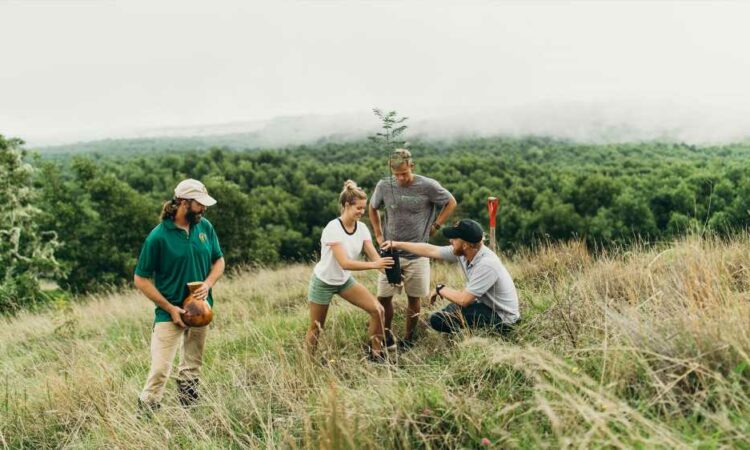When John De Fries came aboard as Hawaii Tourism Authority president in the midst of the pandemic last September, he immediately announced the Malama Hawaii initiative, a multifaceted program that would encourage “mindful travelers” to choose Hawaii and engage in activities that give back to the Islands. Malama loosely translates as “to take care of,” and the statewide initiative incentivizes tourists to participate in volunteer activities, everything from beach clean-ups to planting trees and helping to restore traditional fish ponds, with discounts on hotels and activities.
The goal is to create a more profound connection between visitors, the Hawaiian culture and the Islands’ communities while also contributing to efforts to preserve the destination for future generations.
Tourism is beginning to return to the Islands, and the Malama Hawaii menu of volunteer opportunities has been fleshed out since De Fries’ announcement, offering those visitors numerous options to get to know Hawaii on a deeper level. The program now counts more than 100 industry partners and local organizations that provide inspiring volunteer opportunities, which ultimately leads to regenerative tourism. As part of the campaign, a series of promotional Malama Hawaii videos were produced that touch on a range of topics, from reforestation to aquaculture.
“I’m very excited about the Malama Hawaii campaign,” said Gail Stringer, who was born and raised in Hawaii and now runs Hawaii General Store and HGS Travel in Seattle. “The environment had a chance to regenerate in Hawaii during the shutdown, and it’s important to maintain those gains and also impart environmental and cultural stewardship to the next generations. The tourism industry is so important, and it’s hard to cut down on the number of people coming, so if we can educate people and attract more mindful visitors, it will go a long way.”
Numerous hotels across the Islands are participating in the program, offering resort credits and discounted stays for guests who complete a qualifying volunteer activity. Common activities include beach clean-ups and planting a tree in a native reforestation area that can be scheduled at the guest’s leisure. For a list of these opportunities and special offers from participating hotels, visit www.gohawaii.com/malama.
Here are some of the more unique volunteer options available on the four most visited islands.
Oahu: For Hawaii visitors who wish to steep themselves in U.S. military history, the Battleship Missouri Memorial is inviting volunteers to assist with general maintenance aboard the “Mighty Mo.” Participants can clean, sand, sweep and paint the ship that served in World War II and was the site for the official surrender of Japan to Allied Forces on Sept. 2, 1945.
Malama Loko Ea is an educational platform promoting land stewardship, nohona Hawaii (living and practicing Hawaiian culture as a way of life) and ike ku una (knowledge of traditional Hawaiian practices). Volunteers can help restore a historical Hawaiian fishpond as part of the organization’s Hololea Tour, and other activities include a walking tour, bamboo pole fishing and throw net demonstrations. Community workdays are every Saturday morning, and registration is required.
The nonprofit organization Papahana Kuaola offers two monthly volunteer opportunities for travelers who don’t mind getting dirty. Every third Saturday of the month, volunteers help with stream restoration by removing invasive species that encroach and clog waterways, and every fourth Saturday of the month volunteers work in a loi (taro patch).
Kauai: The Kauai Forest Bird Recovery Project promotes knowledge, appreciation and conservation of Kauai’s native forest birds. The organization focuses on the threatened iiwi , or scarlet honeycreeper, and three federally endangered species — puaiohi, akikiki, and akekee — with the goal of boosting the birds’ wild populations. More adventurous volunteers can go on a two- to five-day hike into the forest with a team to monitor bird numbers and activity. Volunteers looking for a less physically strenuous way to help can work on data entry, equipment maintenance, photo organization and outreach materials for the project.
Big Island of Hawaii: Guide Kimo Duarte, whose family has been stewards of Hualalai volcano since the 1950s, leads an in-depth, hands-on, five-hour tour of the 8,271-foot mountain. The Hualalai Crater Experience with Uluhao o Hualalai traverses the volcano’s Native Hawaiian koa and ohia forests listening to the sounds of native birds, such as the apapane, akepa, iiwi and palila. Participants also visit the Duarte family’s cabin and hike two miles around Hualalai’s summit craters. At the end, they plant a koa sapling in a native forest restoration area.
Hawaii Volcanoes National Park, the state’s most visited attraction, invites volunteers to participate in stewardship work along the picturesque landscapes of Kilauea volcano and the biologically diverse Hawaiian forest Kipukapuaulu. The work includes clearing out invasive species that keep native and understory plants from thriving.
The nonprofit Edith Kanakaole Foundation invites volunteers to participate in its monthly community workdays at Haleolono fishpond just outside of Hilo. The muscle-burning but rewarding work involves restoring and repairing Haleolono’s lava rock sea wall. Participants also learn about Hawaiian aquaculture traditions, including traditional fish farming and the fish and seaweed propagation still practiced at the site.
Maui: The Lahaina Restoration Foundation welcomes volunteers to learn more about Maui’s history through hands-on processing of historical artifacts and documents from all eras of Lahaina’s past. The work includes cataloguing, photographing and transcribing materials dating back to the Kingdom of Hawaii, through the missionary years, the growth of whaling in the Islands and into the sugar plantation era.
The nonprofit Pacific Whale Foundation offers Volunteers on Vacation, an initiative including several different activities that help with the organization’s marine conservation efforts and environmental stewardship of the island. Programs include coastal debris cleanup, planting of native species, sustainable farming work and stream restoration. Volunteers get to access rarely visited areas, learn about the history and natural ecosystem of the area, and receive a free tote bag made of recycled materials when they volunteer for three hours or more.
Source: Read Full Article

